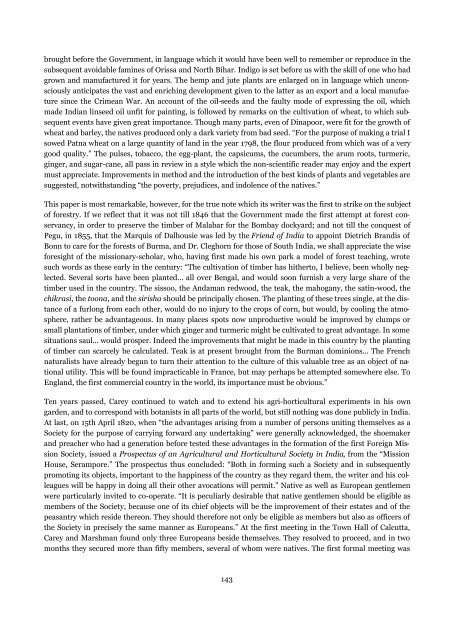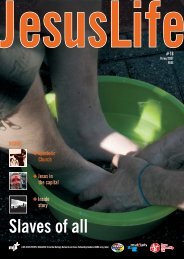Life of William Carey by George Smith - The Jesus Army
Life of William Carey by George Smith - The Jesus Army
Life of William Carey by George Smith - The Jesus Army
You also want an ePaper? Increase the reach of your titles
YUMPU automatically turns print PDFs into web optimized ePapers that Google loves.
ought before the Government, in language which it would have been well to remember or reproduce in the<br />
subsequent avoidable famines <strong>of</strong> Orissa and North Bihar. Indigo is set before us with the skill <strong>of</strong> one who had<br />
grown and manufactured it for years. <strong>The</strong> hemp and jute plants are enlarged on in language which unconsciously<br />
anticipates the vast and enriching development given to the latter as an export and a local manufacture<br />
since the Crimean War. An account <strong>of</strong> the oil-seeds and the faulty mode <strong>of</strong> expressing the oil, which<br />
made Indian linseed oil unfit for painting, is followed <strong>by</strong> remarks on the cultivation <strong>of</strong> wheat, to which subsequent<br />
events have given great importance. Though many parts, even <strong>of</strong> Dinapoor, were fit for the growth <strong>of</strong><br />
wheat and barley, the natives produced only a dark variety from bad seed. “For the purpose <strong>of</strong> making a trial I<br />
sowed Patna wheat on a large quantity <strong>of</strong> land in the year 1798, the flour produced from which was <strong>of</strong> a very<br />
good quality.” <strong>The</strong> pulses, tobacco, the egg-plant, the capsicums, the cucumbers, the arum roots, turmeric,<br />
ginger, and sugar-cane, all pass in review in a style which the non-scientific reader may enjoy and the expert<br />
must appreciate. Improvements in method and the introduction <strong>of</strong> the best kinds <strong>of</strong> plants and vegetables are<br />
suggested, notwithstanding “the poverty, prejudices, and indolence <strong>of</strong> the natives.”<br />
This paper is most remarkable, however, for the true note which its writer was the first to strike on the subject<br />
<strong>of</strong> forestry. If we reflect that it was not till 1846 that the Government made the first attempt at forest conservancy,<br />
in order to preserve the timber <strong>of</strong> Malabar for the Bombay dockyard; and not till the conquest <strong>of</strong><br />
Pegu, in 1855, that the Marquis <strong>of</strong> Dalhousie was led <strong>by</strong> the Friend <strong>of</strong> India to appoint Dietrich Brandis <strong>of</strong><br />
Bonn to care for the forests <strong>of</strong> Burma, and Dr. Cleghorn for those <strong>of</strong> South India, we shall appreciate the wise<br />
foresight <strong>of</strong> the missionary-scholar, who, having first made his own park a model <strong>of</strong> forest teaching, wrote<br />
such words as these early in the century: “<strong>The</strong> cultivation <strong>of</strong> timber has hitherto, I believe, been wholly neglected.<br />
Several sorts have been planted... all over Bengal, and would soon furnish a very large share <strong>of</strong> the<br />
timber used in the country. <strong>The</strong> sissoo, the Andaman redwood, the teak, the mahogany, the satin-wood, the<br />
chikrasi, the toona, and the sirisha should be principally chosen. <strong>The</strong> planting <strong>of</strong> these trees single, at the distance<br />
<strong>of</strong> a furlong from each other, would do no injury to the crops <strong>of</strong> corn, but would, <strong>by</strong> cooling the atmosphere,<br />
rather be advantageous. In many places spots now unproductive would be improved <strong>by</strong> clumps or<br />
small plantations <strong>of</strong> timber, under which ginger and turmeric might be cultivated to great advantage. In some<br />
situations saul... would prosper. Indeed the improvements that might be made in this country <strong>by</strong> the planting<br />
<strong>of</strong> timber can scarcely be calculated. Teak is at present brought from the Burman dominions... <strong>The</strong> French<br />
naturalists have already begun to turn their attention to the culture <strong>of</strong> this valuable tree as an object <strong>of</strong> national<br />
utility. This will be found impracticable in France, but may perhaps be attempted somewhere else. To<br />
England, the first commercial country in the world, its importance must be obvious.”<br />
Ten years passed, <strong>Carey</strong> continued to watch and to extend his agri-horticultural experiments in his own<br />
garden, and to correspond with botanists in all parts <strong>of</strong> the world, but still nothing was done publicly in India.<br />
At last, on 15th April 1820, when “the advantages arising from a number <strong>of</strong> persons uniting themselves as a<br />
Society for the purpose <strong>of</strong> carrying forward any undertaking” were generally acknowledged, the shoemaker<br />
and preacher who had a generation before tested these advantages in the formation <strong>of</strong> the first Foreign Mission<br />
Society, issued a Prospectus <strong>of</strong> an Agricultural and Horticultural Society in India, from the “Mission<br />
House, Serampore.” <strong>The</strong> prospectus thus concluded: “Both in forming such a Society and in subsequently<br />
promoting its objects, important to the happiness <strong>of</strong> the country as they regard them, the writer and his colleagues<br />
will be happy in doing all their other avocations will permit.” Native as well as European gentlemen<br />
were particularly invited to co-operate. “It is peculiarly desirable that native gentlemen should be eligible as<br />
members <strong>of</strong> the Society, because one <strong>of</strong> its chief objects will be the improvement <strong>of</strong> their estates and <strong>of</strong> the<br />
peasantry which reside thereon. <strong>The</strong>y should therefore not only be eligible as members but also as <strong>of</strong>ficers <strong>of</strong><br />
the Society in precisely the same manner as Europeans.” At the first meeting in the Town Hall <strong>of</strong> Calcutta,<br />
<strong>Carey</strong> and Marshman found only three Europeans beside themselves. <strong>The</strong>y resolved to proceed, and in two<br />
months they secured more than fifty members, several <strong>of</strong> whom were natives. <strong>The</strong> first formal meeting was<br />
143
















